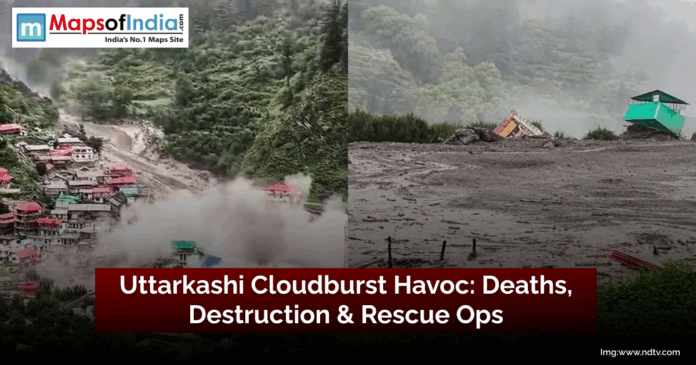The calm and picturesque backdrops of Uttarkashi, in the lap of the Himalaya, were shaken once again by the anger of nature. The area was recently hit by a disastrous cloudburst, causing huge floods, landslides and destruction of infrastructure, which has rocked the district in its wake. Although natural disasters are not new to Uttarkashi, the magnitude of such a cloudburst and the resulting devastation has taken its toll, such that lives are lost and many villages are isolated by the locals.
A Night of Terror Unleashed
The cloudburst was at a late hour, and many residents were caught unprepared as they slept after experiencing a normal day. In a few minutes, the torrential rainwater turned into a deadly storm, which led to flooding streets, homes, and rivers exceeding their danger levels. The worst affected are Gangotri Valley, Barkot, a large portion of Mori and Purola, as these received the impact of the sudden downpour.
The first people to witness the event described it as apocalyptic, stormy water flowing through steep crevices, flattened trees and boulders falling off the hills. Adding to the mess were power lines that broke, roads that disappeared, and mobile networks that went down. At dawn, Uttarkashi hills, which previously looked peaceful, were covered with mushy debris of crashed buildings and families desperate on the grounds of hope.
Casualties and Missing Persons
When rescue squads hurriedly made it to the troubled areas, macabre statistics started to appear. The authorities had identified more than a dozen of those killed, with multiple others injured, and some are still missing. The figure may increase as communication to remote hamlets is enhanced. Families are separated, many families saying that their child or elderly relative or neighbour has never been found since that evening of the cloudburst.
The local government has already established the temporary accommodation facilities where displaced locals can stay; however, many of them are still sleeping under the open sky, among the rubble and the remnants of where their houses used to be.
Infrastructure Reduced to Ruins
Other than the loss of life, the infrastructure has been devastating. The highways along the nation and states have been badly ruined, and significant roads and paths are obstructed by landslides, as the major one is the Rishikesh-Gangotri road. There have been incidents where bridges have been swept away by the rush of water, as well as cases where their pipelines and power grid have been tangentially swept away entirely.
Homes erected at the banks of rivers and on hill sides that are exposed have been washed away. Places of worship, local health facilities and schools have also been destroyed. Farming activities in agricultural areas have been destroyed, cows stolen, and land has been left covered with mud and rubble- all of which will have long-term economic consequences among the affected families.
Rescue Operations in Full Swing
Emergency services mobilization was prompted by the government. Rescue and relief have been placed in the form of teams sent by the National Disaster Response Force (NDRF), State Disaster Response Force (SDRF), Indo-Tibetan Border Police (ITBP) and the Army. The helicopters are also being utilized in inaccessible and remote locations in order to fly stranded villagers and religious supplies.
On the one hand, the rescue workers have carried out their work around the clock all over the country to locate the survivors, clean the debris and reopen communication channels under extremely difficult conditions because of the steep terrain and unavoidable rains. There has been an establishment of medical camps to treat the injured, and there is the distribution of food and water to the displaced.
Local volunteers have helped the district administration, which has played a pivotal role in the management of shelters and organization of resources. Youth groups and Non-Governmental Organizations in most villages are also helping in the coordination efforts, clearing of roads and helping the affected families.
Communication and Transport Breakdown
The domination of transport and communication has been one of the most direct effects of the cloud burst. Significant avenues are either underwater or engulfed by earth slides. A number of villages are totally isolated because their access roads are ruined, and it becomes hard to reach them in time with relief.
Only partially functioning telecom services are available. Power outages have been rampant, and residents are unable to charge their phones or get internet access to connect to their families. This cyber silence has caused enormous tension among family members who are not part of the area.
Government Response and Relief Measures
The Chief Minister of Uttarakhand himself came to the disaster-hit area, surveyed the extent of damage and assured support to relief and rehabilitation activities in full. This has placed the provision of compensation to the families of the deceased people, as well as supporting the others with their loss of homes and livelihoods through an emergency fund.
There are also special teams evaluating the destruction of public and school facilities, as well as roads, to be restored as early as possible. Still in the state government, coordination with the central resources is being done to maintain a smooth support and supply chain in logistics.
Warning Systems and Preparedness
The tragedy once again initiated the issue of preparedness of hilly areas such as Uttarkashi in tackling cloudbursts and flash floods. According to the experts, despite the use of cloud burst early warning systems, their scope and functionality in peripheral regions cannot be termed as efficacious on a large scale.
There seems to be increased worry over the uncontrolled construction near river banks and areas sensitive to the ecology, where this is aggravating the effects of such natural calamities of nature. The locals and environmental activists have been lamenting that building regulations should be rigidly implemented and more enlightenment programs on disaster management provided.
Climate Change and Recurring Disasters
Cloud bursts are not something new to the Himalayan region, but there has been an alarming increase in the frequency and intensity of these. Most meteorologists and climate scientists think the increase in rainfall is being caused by climate change due to inconsistency in rainfall, especially concentrated falls in a short time.
Such shocks are becoming more likely to take place in the fragile topography of Uttarakhand, along with human interference. It is evident even in the recent cloudburst at Uttarkashi, followed by the 2013 Kedarnath disaster and the recurrent floods in Chamoli, that there is something akin to an overall environmental crisis that is in peril.
Voices from the Ground
There is a shining light out of the darkness, tales of survival and bravery. Locals have told of people who have run into burning buildings to rescue fellow citizens, of community kitchens serving hundreds even in ration times, of townsmen hauling up the casualties of enemy fire on their backs up the hills to be able to receive medical care.
“We survived living down there. We lost everything; our house, our cattle, but we thank god we are alive, Ramesh Rawat of Barkot said. We would like now to think of nothing more than a secure roof protection, something to start with again.”
Conclusion: Healing and Rebuilding Ahead
Uttarkashi cloudburst is a wake-up call to the increasing susceptibility of the hilly topographies in India. The long road to recovery has only just begun, even as rescue and relief operations take place. Physical reconstruction of lives, infrastructure restoration and planning for future disasters should be used simultaneously.
It is critical that policy makers, environmental experts and citizens join the effort, not only responding to disasters, but guarding against and reducing disasters with sustainable planning and development.




